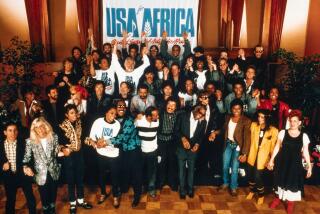Astaire’s Happy Feat ... Singing
- Share via
The voice was thin but confident. At the top of its narrow range it verged on the falsetto. The lowest notes were achieved with a kind of surprised satisfaction that showed on the screen. Yet Fred Astaire the singer inspired some of the century’s best songwriters to do their most memorable work.
The Gershwins, Cole Porter, Irving Berlin, Jerome Kern and others wrote for the man whose honest, unpretentious singing--a style so simple that it concealed the fact that it was a style--revealed the melodies and the lyrics in all their charm, originality and verve.
The songs Astaire introduced, from “Night and Day” to “A Foggy Day” to “Cheek to Cheek” and “Let’s Call the Whole Thing Off” (among the dozens), are now part of our collective memory, recorded by Frank Sinatra and many other artists but forever associated with the man whose singing seemed as pure and natural as his dancing.
Astaire the singer has now been celebrated in “The Fred Astaire Songbook,” a “Great Performances” special (airing Friday at 8 p.m. on Channel 50 and at 9 p.m. on Channels 28 and 15), with Audrey Hepburn--to whom Astaire sang “Funny Face” in the picture of the same name--as the hostess.
In addition to the inevitable (and delicious) clips from the movies, there are some visual rarities. Chief among these is an excerpt from a contrasty black-and-white kinescope (unseen since the original broadcast) of an Astaire visit to Oscar Levant’s celebrated syndicated talk show in the late ‘50s, Astaire sitting on a stool, singing, while Levant pounds out a rather competitive accompaniment.
There is as well a clip from a later Dick Cavett show, when Astaire sang one of the several songs he himself wrote: “I’m Building Up to an Awful Let-Down,” with lyrics by Johnny Mercer. A third rarity is home-movie footage shot by George Gershwin himself of Astaire rehearsing a generally forgotten number called “Slap That Bass.”
“My father (Vincente Minnelli, who directed Astaire in ‘Ziegfeld Follies’ and other films) always told me,” daughter Liza says on the show, “that when Fred would interpret a lyric, he put so much thought into it that it sounded almost like he was speaking, that it furthered the plot of whatever movie he was in, that it was conversational and, therefore, it was personal.”
There are singers--Tony Bennett, Frank Sinatra--you can’t hope to sound like. There are others--Bing Crosby, Perry Como, Fred Astaire--that you could almost imagine sounding a little bit like, if the acoustics in the shower are working right. Film critic Richard Schickel summed it up on the show: Astaire “made us feel if we could sing at all and if we could have sung to a girl, we’d probably imagine that we would sing a little like Fred Astaire.”
Maybe the singing was a consolation prize for us. What was all too clear was that you couldn’t dance like Astaire if you took lessons forever. The film excerpts from “The Fred Astaire Songbook” are splendidly rich in dance as well as song, for the lyrics seemed invariably to lead to the dance floor. The turns include “A Couple of Swells” with Judy Garland, and the magical dancing-on-the-ceiling number from “Royal Wedding.”
It’s a lovely way to spend a Friday evening. Joan Kramer and David Heeley produced, Heeley directed and the script was written by John L. Miller.
More to Read
Only good movies
Get the Indie Focus newsletter, Mark Olsen's weekly guide to the world of cinema.
You may occasionally receive promotional content from the Los Angeles Times.






